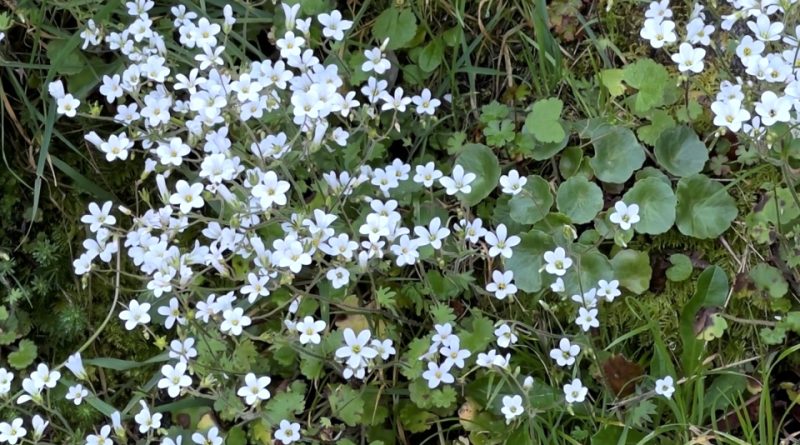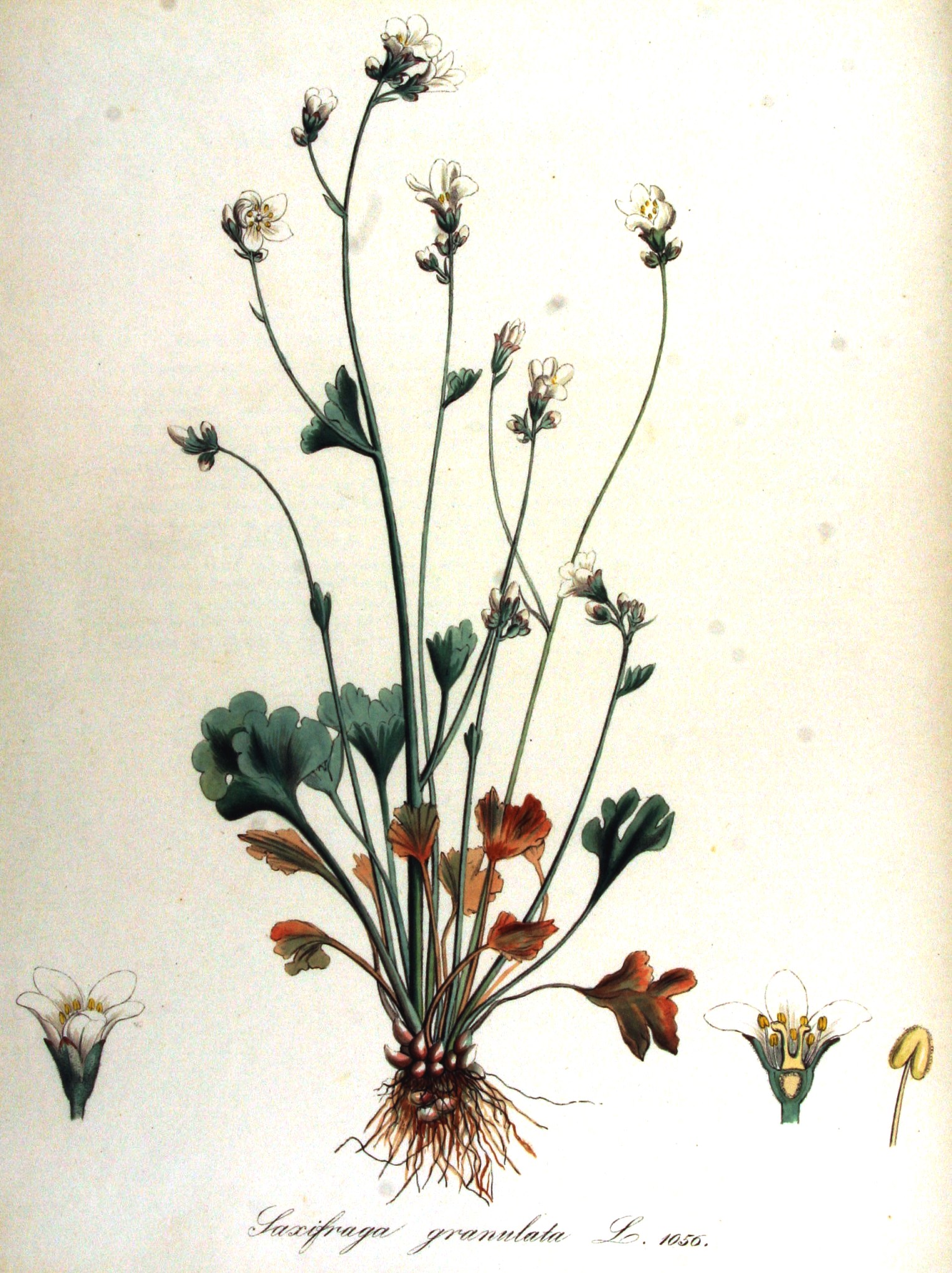Saxifraga granulata
Saxifraga granulata
The Stone crusher plant or Meadow saxifrage (Saxifraga granulata L.) is a herbaceous species belonging to the Saxifragaceae family.
Systematics –
From a systematic point of view it belongs to:
Eukaryota Domain,
Kingdom Plantae,
Subarign Tracheobionta,
Spermatophyta superdivision,
Magnoliophyta Division,
Magnoliopsida class,
Subclass Rosidae,
Rosales Order,
Saxifragaceae family,
Genus Saxifraga,
S. granulata species.
The following terms are synonymous previously used:
– Evaiezoa granulata (L.) Raf.;
– Saxifraga aemula Sennen;
– Saxifraga alba Bubani;
– Saxifraga alba Garsault;
– Saxifraga altifida Haw.;
– Saxifraga bulbosa Hochst.;
– Saxifraga bulbosa Hochst. ex Engl.;
– Saxifraga carnosa Lucé;
– Saxifraga carnosa Sweet;
– Saxifraga castellana Boiss. & Reut.;
– Saxifraga castellana Boiss. & Reut. ex Nyman;
– Saxifraga cernua Lapeyr.;
– Saxifraga corymbosa Lucé;
– Saxifraga elegans Zeyh.;
– Saxifraga elegans Zeyh. ex Schrank;
– Saxifraga elegantula Boiss.;
– Saxifraga elegantula Boiss. ex Ball;
– Saxifraga glaucescens Boiss. & Reut.;
– Saxifraga glaucescens var. minor Willk.;
– Saxifraga granulata subsp. fernandesii Redondo & Horjales;
– Saxifraga granulata subsp. glaucescens (Reut.) Rivas Mart., F.Fernández & D.Sánchez;
– Saxifraga granulata subsp. graniticola D.A.Webb;
– Saxifraga granulata subsp. penduliflora (Bastard) Bonnier & Layens, 1894;
– Saxifraga granulata var. borealis Engl. & Irmsch., 1916;
– Saxifraga granulata var. glaucescens (Boiss. & Reut.) Engl.;
– Saxifraga granulata var. glaucescens P.Fourn., 1936;
– Saxifraga granulata var. mauritii Sennen;
– Saxifraga granulata var. rouyana (Magnier) Engl. & Irmsch., 1916;
– Saxifraga hochstetteriana Lange;
– Saxifraga hochstetteriana Lange ex Nyman;
– Saxifraga lopesiana Samp.;
– Saxifraga officinarum Crantz;
– Saxifraga paniculata Willk.;
– Saxifraga penduliflora Bastard;
– Saxifraga recta Sennen & Elías;
– Saxifraga rivularis P.Thomas;
– Saxifraga rivularis P.Thomas ex DC.;
– Saxifraga rouyana Magnier;
– Saxifraga sampaioi Rozeira.
Etymology –
The term Saxifraga comes from sáxum sasso and from frángo to break, to split: since plants of this genus often grow on rocks, where they are able to insinuate their roots even in small cracks and to break as stones grow. Another interpretation refers to the kidney stones that these herbs would be able to crumble.
The specific granulated epithet comes from granulum granello (diminutive of granum): grainy, sprinkled with granules, dotted.
Geographic Distribution and Habitat –
Saxifraga granulata is a European plant with a sub-Atlantic distribution, present in Western Europe and even further east in areas with a sub-oceanic climate.
In Italy it is present in all regions except in the north-east and in Sardinia.
Its habitat is that of arid and rocky pastures, from sea level to the lower mountain belt, from the plain up to 1,600 m a.s.l.
Description –
The Saxifraga granulata is a perennial, herbaceous, glandular-viscous plant that grows around 20-50 cm in height. in height.
It has a tuberous root.
The stems are erect, simple or branchy in the upper part. At the base of the stem, but sometimes also underground, there are ovoid, pink bulbils.
The basal leaves are rosette, long petiolate, the petiole is hollowed out and 2 times longer than the limbus, the lamina is reniform and the margin lobe-crenate; the few cauline leaves are alternate, the upper sessile with 3 ÷ 5 deep lobes.
The flowers (3 ÷ 7) are gathered in loose and erect inflorescences and are carried by glandular peduncles, as is the glandular calyx with 5 lanceolate sepals; the corolla is composed of 5 spatulated petals, white with very light yellow-green veins, hairless; 10 stamens arranged in a circle carry yellow anthers.
Its flowering period is between the months of April-June.
The fruits are oval capsules.
Cultivation –
The Meadow saxifrage is a rare plant that originates in sub-Atlantic areas, which grows spontaneously in arid and rocky pastures, at altitudes between 0-1600 meters above sea level and which is occasionally collected and used for medicinal use.
Its cultivation is possible both starting from seed and through the cloves present at the base of the stem or in the underground part of the plant.
Customs and Traditions –
The Meadow saxifrage is a rather rare herbaceous perennial plant that grows in some areas of Europe and also in some Italian regions and which contains some substances such as: tannins, vitamin C and bitter substances.
In traditional medicine and homeopathy it is used in case of kidney and bladder pain.
The Saxifraga granulata has the power to slowly break up kidney and bladder stones, in fact, this herb is also called “stone breaker”.
Its main use is in case of urinary problems, stones and pain in the bladder, liver and spleen congestion. Other of its fundamental properties are: cholagogue, anti-inflammatory for the prostate, diuretic.
Preparation Method –
The Meadow saxifrage is a plant that in some areas where it grows has been used for medicinal uses.
In phytotherapy the parts used are the roots, the flowers and the fresh leaves.
However, there are formulations on the market with indications relating to use.
Guido Bissanti
Sources
– Acta Plantarum – Flora of the Italian Regions.
– Wikipedia, the free encyclopedia.
– Useful Tropical Plants Database.
– Conti F., Abbate G., Alessandrini A., Blasi C. (ed.), 2005. An annotated checklist of the Italian vascular flora, Palombi Editore.
– Pignatti S., 1982. Flora of Italy, Edagricole, Bologna.
– Treben M., 2000. Health from the Lord’s Pharmacy, Advice and experiences with medicinal herbs, Ennsthaler Editore.
Photo source – https://inaturalist-open-data.s3.amazonaws.com/photos/114350334/original.jpg
Warning: Pharmaceutical applications and alimurgical uses are indicated for informational purposes only, they do not represent in any way a medical prescription; therefore no responsibility is taken for their use for curative, aesthetic or food purposes.


